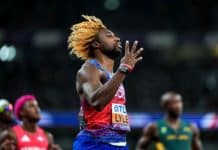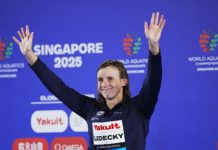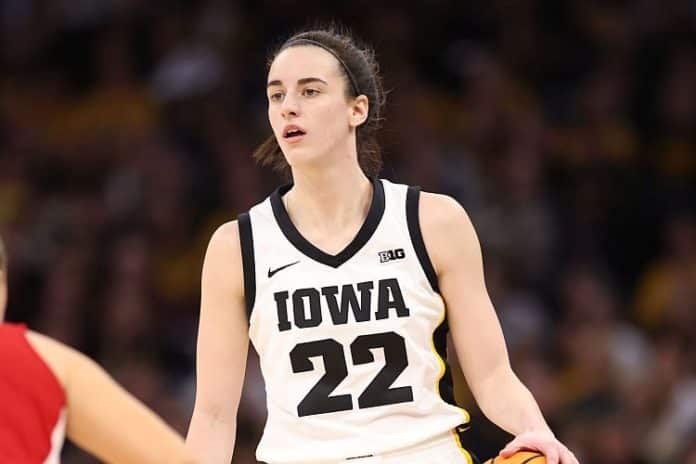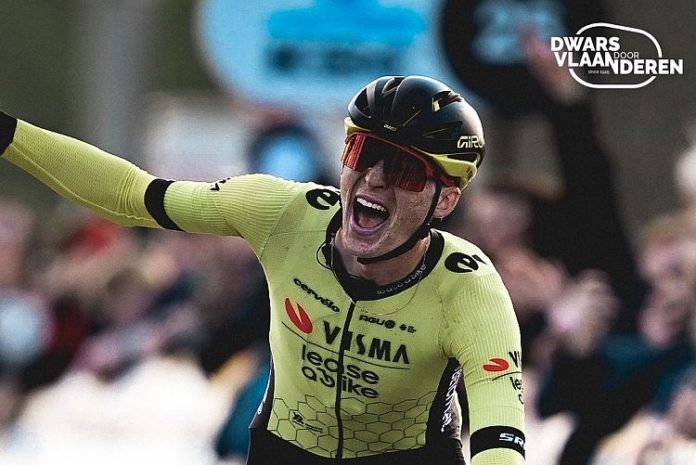★ The Sports Examiner: Chronicling the key competitive, economic and political forces shaping elite sport and the Olympic Movement.★
★ To get The Sports Examiner by e-mail: sign up here! ★
★ Last chance! Please help with our winter donation drive! Now 43 donors have covered 76.0% of our tech and support costs. Please consider a contribution to help keep TSX going. Thank you. ★
≡ THE 5-RING CIRCUS ≡
1. Caitlin Clark invited to U.S. training camp in Cleveland
2. Malinin’s Worlds Free Skate show draws 1.56 million on NBC!
3. World Boxing publishes 2024-28 strategic plan
4. Garnbret warns against eating disorders in Sport Climbing
5. Poverty plaguing Canadian athletes, now asking for a raise
● She may be busy leading her Iowa Hawkeyes in the NCAA women’s basketball tournament, but Caitlin Clark has the attention of USA Basketball, which invited her to its national-team training camp during the women’s Final Four in Cleveland. But Clark may already be there with her team.
● Even with the NCAA men’s basketball tournament against it, the men’s Free Skate at last Saturday’s ISU World Figure Skating Championships drew more than $1.56 million on NBC, to see U.S. star Ilia Malinin win his first Worlds gold. The Spanish-language audience for the USA-Mexico CONCACAF Nations League final was impressive too.
● The new World Boxing group published its Strategic Plan 2024-28, aiming to become the new, recognized International Federation for the sport. It has an uphill battle, and time is short, as the IOC will likely only wait to 2026 to see if boxing will be held at LA28.
● Slovenian Olympic climbing star Janja Garnbret warns against eating disorders in her sport, now common in a misplaced drive for lower weight; the international federation created a new protocol to monitor athlete health indicators this season.
● Painful report on Canadian bobsledders and rower who are struggling to survive financially and asking the Canadian government to increase direct-athlete funding by C$6.3 million in 2024, and index future funding for inflation.
● Panorama: Paris 2024 (remarkable salary control revealed in organizing committee budget “investigation”) = Winter Games 2034 (Salt Lake City plan for 2034 rearranges 2002 venue plan to handle event expansion) = USOPC (three Para-sport championships to be included in NCAA events) = Athletics (World Cross Champs coming Saturday from Serbia) = Cycling (2: surgery for van Aert after major crash this week; a $60,000 track cycling bike?) ●
1.
Caitlin Clark invited to U.S. training camp in Cleveland
The U.S. women’s basketball team is an Olympic dynasty, having won seven straight tournament golds and riding a 55-game win streak in Olympic play going into 2024.
Even with a roster of WNBA all-stars available, there is one burning question that has not yet been answered about the 2024 American roster:
What about Caitlin Clark?
The Iowa mega-star will lead the Hawkeyes (31-4) into the NCAA women’s regional semifinals on Saturday against Colorado in Albany, New York, and with a win, would advance to the regional final on Monday.
But Clark now also has an invitation to join the U.S. women’s national team training camp, as USA Basketball announced its roster for the 3-5 April program in Cleveland, Ohio, that will be held concurrently with the NCAA women’s Final Four:
“Caitlin Clark will attend training camp, contingent on University of Iowa’s progression through the NCAA Tournament.”
The Final Four semifinals will be held on Friday, 5 April in Cleveland, with the final on Sunday (7th). If Iowa is in, she’ll miss the training camp.
But the U.S. federation has sent the message that Clark is on the radar for selection. Importantly, she is no stranger to international play: she owns two consecutive golds from the FIBA U-19 women’s World Cups in 2019 and 2021, and was named Most Valuable in the 2021 tournament in Hungary.
The group she might join is layered with stars, starting with five-time Olympic champion Diana Taurasi (2004-08-12-16-20), two-time gold winners Brittney Griner (2016-20) and Breanna Stewart (2016-20) and six Tokyo winners: Ariel Atkins, Chelsea Gray, Jewell Loyd, A’ja Wilson and two women’s 3×3 winners: Kelsey Plum and Jackie Young.
Clark would prefer to be back in the Final Four, trying to move up from second in 2023 to the national title in 2024. But if not, it looks like she’ll be in Cleveland anyway.
The actual Olympic Team selection will come at a later date.
2.
Malinin’s Worlds Free Skate show draws 1.56 million on NBC!
The U.S. put on a good show at the ISU World Figure Skating Championships in Montreal last week, with Ilia Milanin winning the men’s competition, Madison Chock and Evan Bates repeating as Ice Dance winners and Isabeau Levito taking the women’s silver.
And when Malinin came on for what turned out to be a historic performance – the second-highest score ever, to win his first Worlds gold – U.S. fans were ready.
The live, 8-10 p.m. broadcast of the men’s Free Skate last Saturday (23 March) drew an average of 1.561 million fans on NBC, also shown on the Peacock streaming service (not included in the total).
That made it the 11th-highest-rated sports program of the day, according to Nielsen, and no. 3 in its time slot. All of the shows ahead of them were NCAA men’s tournament broadcasts!
As usual, being on NBC mattered and the other skating Worlds telecasts on cable did not do nearly as well:
● 21 Mar. (Thu.): 170,000 for men’s Short Program (USA: 1 p.m. Eastern)
● 21 Mar. (Thu.): 238,000 for Pairs Short Program (USA; 8 p.m. Eastern)
● 22 Mar. (Fri.): 331,000 for women’s Free Skate (USA; 8 pm. Eastern)
● 23 Mar. (Fri.): 304,000 for Ice Dance Free Dance (USA: 3 p.m. Eastern)
● 23 Mar. (Sat.): 1.561 million for men’s Free Skate (NBC: 8 p.m. Eastern)
Even with the strong audience for the men’s Free Skate on NBC, younger audiences were not moved. The NBC telecast drew only 38,000 in the 18-34 age group, and the earlier Ice Dance show on USA – with Chock and Bates – drew only 4,000 in that demographic. For the evening NCAA games opposite the NBC show, Tennessee-Texas drew 6.656 million in total and 841,000 from 18-34; the Oakland-North Carolina State game had a 3.293 million total audience and 541,000 from 18-34.
Nevertheless, the 1.561 million on NBC is the second-best for skating this season, behind only the 2.207 million for the women’s Free Skate at the U.S. Nationals on NBC on 26 January.
¶
The CONCACAF Nations League semifinals at AT&T Stadium in Arlington, Texas, were shown only on Paramount+ in English, but also by Univision’s TUDN in Spanish:
● 21 Mar. (Thu.): 140,000 for U.S. vs. Jamaica on TUDN (6:28 p.m. Eastern)
● 21 Mar. (Thu.): 294,000 for Panama vs. Mexico on TUDN (9:37 p.m. Eastern)
● 24 Mar. (Sun.): 395,000 for Panama vs. Jamaica on UniMas (5:25 p.m. Eastern)
● 24 Mar. (Sun.): 121,000 for Panama vs. Jamaica on TUDN (5:25 p.m. Eastern)
● 24 Mar. (Sun.): 2.301 million for U.S. vs. Mexico on Univision (8:33 p.m. Eastern)
● 24 Mar. (Sun.): 484,000 for U.S. vs. Mexico on TUDN (8:33 p.m. Eastern)
The combined 2.785 million Spanish-language viewers for the Sunday final ranked no. 8 on the day, behind seven NCAA men’s Tournament games and a NASCAR race on Fox, and no. 3 in its time slot. The Sunday matches drew age 18-34 audiences of 79,000 for Panama-Jamaica and 499,000 for USA-Mexico.
Also strong last week was the NCAA Wrestling Championships on ESPN, which drew an average of 300,250 across four shows:
● 21 Mar.: 282.000 on ESPN (7 p.m. Eastern)
● 22 Mar.: 399,000 on ESPN (8 p.m. Eastern)
● 23 Mar.: 110,000 on ESPNU (11 a.m. Eastern)
● 23 Mar.: 410,000 on ESPN (7 p.m. Eastern)
NBC had reason to be cheered about interest in swimming, with a Saturday highlights program of the two-weeks-ago Tyr Pro Swim Series at Westmont, Illinois averaging 503,000 viewers on NBC on Saturday (23rd) at 1 p.m. Eastern, again up against the NCAA basketball tournament.
3.
World Boxing publishes 2024-28 strategic plan
Boxing as an Olympic sport is in limbo. Its longtime international federation, now called the International Boxing Association, was de-recognized by the International Olympic Committee last year.
IOC Sports Director Kit McConnell (NZL) told reporters last week that patience with boxing by the IOC Executive Board was thinning, as the IOC was overseeing Olympic competitions for a second consecutive Games:
“The IOC E.B. made it clear, once again, that this must be the last time that such a process can be undertaken by the IOC. Following the decision by the IOC Session last year, the inclusion of boxing in the LA28 Olympic programme is on hold and not confirmed.
“If there is no boxing body supported and driven by the National Federations, we will not be in a position to include boxing in the Olympic programme.
“So it’s now up to the National Federations to drive this change and to work to create a body that we can work in partnership with, because we cannot move forward with this current situation.”
The new player in the game is World Boxing, which held its foundational Congress in November 2023 and which published its Strategic Plan 2024-28, with five prime objectives:
● “Establish World Boxing as a recognised credible organisation
● “Operate best practice governance
● “Deliver world standard competitions
● “Increase the worldwide media exposure of boxing
● “Achieve financial stability and sustainability”
The first goal is the key to all of the others and the plan lists five must-have goals:
(1) “Obtain International Olympic Committee recognition for Boxing.
(2) “Ensure Boxing remains on the Olympic Programme. Ensure the maximum medals and maximum athlete quotas for boxing at the Olympic Games.
(3) “Build strong relationships and obtain membership of sport umbrella organisations such as, ASOIF, SportAccord and WADA, Commonwealth Games Federation, ANOC, Continental Olympic Associations.
(4) “Build and maintain the image of Olympic style boxing.
(5) “Deliver fair and trustworthy boxing competitions.”
All the other objectives are achievable if these first five are met, and the plan outlines activities for each item, focused on improving relationships with all levels of international sport – starting with the IOC – especially through better communications and personal contacts.
On the fairness of competitions, the plan importantly calls for “independent third-party oversight for results of bouts,” standardized performance reviews of referees and judges and “new technology to support the enforcement of fair bouts.”
A noteworthy task under the third objective on “world standard competitions” is:
“Make competition strategy easier to understand for audience. Make the event more of a show for the audience (eg. Use of graphics, light, music, data)”
This could be a major change in the sport. Punch statistics are already available, but can be substantially upgraded, and it is worth considering how to show the boxers – as well as fans – live scoring, so everyone knows the situation in real time.
The fourth strategic goal, on increasing media exposure, importantly identifies “Consistent timing of events and regular content production that supports story creation and generate[s] news.” In today’s continuous news cycle, the recognition of timing as a crucial component of credibility is at the beginning of a true understanding of how to raise the sport’s profile.
World Boxing has only 27 member federations at present, and at last November’s congress, said that it is targeting 50 by the end of 2024. IOC Sports Director McConnell said at last week’s news conference that for boxing to be included for LA28, a new federation will have to be in place sometime in 2026.
Time is short.
4.
Garnbret warns against eating disorders in Sport Climbing
If there is a true superstar in Sport Climbing, now a permanent part of the Olympic sports program, it’s Tokyo Olympic champ and eight-time World Champion Janja Garnbret of Slovenia.
She won the women’s combined competition in Tokyo and is the favorite for the combined Boulder-Lead event in Paris this summer. But she spoke to CNN Sports about a significant problem plaguing the sport: weight.
“This is a cultural thing in climbing, it’s integrated in our brains that the lighter you are, the stronger you are.
“Of course you don’t want to weigh too much, but you don’t want to weigh too little and so you just have to be something in the middle.
“I’m a strong believer that you can do climbing, or any sport, in a healthy way.”
The problem is identified as Relative Energy Deficiency in Sport or REDs, already a concern for the International Sport Climbing Federation (IFSC). It issued a new protocol in February, creating a more comprehensive screening procedure to obtain an accurate picture of an athlete’s health, not simply based on body-mass index.
Athletes are to provide baseline data on themselves, especially height, weight, heart rate and blood pressure at the start of the season, which will be monitored. The IFSC will conduct both random and focused testing during the season, looking at all of these elements and working with an independent, expert commission to analyze the data.
The story noted:
“Left untreated, medical experts say REDs can damage an athlete’s metabolism, their bone health – leading to more fractures – their immune system, their cardiovascular health, their menstrual cycle, and mental health, as well as their athletic performance.”
Garnbret explained to CNN Sport:
“When you see someone winning, you want to be like them. You want to have results like them. You want to look like them.
“I was the same, but luckily I didn’t fall into this trap. I had people around me to guide me on the right path.
“I had friends who fell into this trap, and I tried to help them in any way possible. I was trying hard for, let’s say, two years to help them get out of it, but I couldn’t help. It was really hard for me to see them destroying themselves, mentally and physically.”
5.
Poverty plaguing Canadian athletes, now asking for a raise
“With the 2024 Olympic and Paralympic Games in Paris on the horizon, Canada’s athletes are asking for a $6.3 million raise to the Athletes Assistance Program (AAP), informally known as ‘carding’ money, in the federal government’s April 16 budget.
“A monthly cheque of $1,765, $1,060 for a development-level athlete, is for living expenses and competition costs their sport’s governing body doesn’t cover.” (C$1 = $0.74 U.S.)
That’s from a Canadian Press story that profiles the financial difficulties for female bobsledders Cynthia Appiah and Melissa Lotholz, and rower Andrea Proske. Canada – like every other country except the U.S. – spends government funds to support athletes in Olympic sports; the Athlete Assistance Program in 2023-24 was budgeted at C$33 million, to support more than 1,800 athletes in 94 different sports disciplines.
Appiah, a former shot putter who was a Beijing 2022 Olympic bobsledder and won an IBSF World Cup bronze in the Monobob this season and ranked eighth in the World Cup seasonal standings in both the Mono and the Two-Woman sleds.
She can get C$21,000 from the Athlete Assistance Program and about C$7,000 from an Ontario Provincial grant and some small sponsorships. She said that when she goes to the national bobsled training center in Calgary, she “couch surfs” with friends to save money.
Proske, 37, a member of Canada’s Tokyo Olympic gold medalists in the women’s Eights, said:
“In women’s rowing, especially as a top-tier gold medallist, I put myself into debt and my husband into debt trying to stand in the middle of the podium with the Maple Leaf on my chest.
“We are not professional athletes. We’re amateur athletes. Many of our sports do not pair very well with sponsorships. Using rowing as example, I can’t sell any sponsorship space on my boat, I can’t put a logo on my visor, I am limited in how many logos I have.”
So, the AthletesCAN group, made up of national-team athletes in Canada, has asked the Canadian government for that added C$6.3 million, but also for the AAP annual appropriation to be indexed for inflation:
“Today, the AAP is no longer reflective of the reality that athletes experience while pursuing their sports at the international level. Athletes are experiencing rising costs like all Canadians, with the majority of National Training Centres located in Canada’s most expensive cities – including Toronto, Vancouver/Victoria and Calgary – which have experienced a 13.1 per cent year-over-year increase in average rent, on top of increasing costs for team fees, equipment, travel and health and wellness.”
These asks are separate from a request by the Canadian Olympic Committee for C$104 million in additional support for its national sports organizations.
Appiah would hardly be able to live pleasantly if the increases were granted, but it would help:
“The AAP is, for most people, is their only source of income, so you make decisions that no sane person would actually make.
“If we had that increase of 18 per cent and then also tied to inflation, we can live like normal human beings for the most part.”
Observed: One of the key takeaways from this story, heard over and over again across multiple sports and multiple countries, is that the Olympic program includes many sports which are not only commercially unsuccessful, but dozens which might fold completely as worldwide programs if not for shares of the television money that the IOC receives for the Olympic and Winter Games, principally from the U.S. and Europe.
After the excitement of the Paris 2024 Olympic and Paralympic Games subsides in the fall, will the IOC begin looking at the program post-2028 for possible changes? Does it have to commit to 30 or more sports at the Olympic Games?
For 2028, the Los Angeles organizers have brought in baseball and cricket, two sports with very significant commercial foundations, as well as flag football, backed by the National Football League. Lacrosse and squash are less well funded.
But is it even advisable to continue including sports which, except for the IOC’s distributions, could not fund their own operations on an annual basis? That’s a question that deserves discussion.
≡ PANORAMA ≡
● Olympic Games 2024: Paris ● A Thursday story on the France 2 TV channel program “Further Investigation” reported on an 11 December 2023 internal version of the Paris 2024 organizing committee budget it obtained.
Of the €4.397 billion total, €584.8 million was listed for officer and staff salaries, or 13.3% of the total. (€1 = $1.08 U.S. today).
That’s amazingly low, with Paris 2024 President Tony Estanguet paid €270,000 and chief executive Etienne Thobois at €260,000. There were – supposedly – shocked reactions, of course, from silly public officials on the program, but this is remarkable salary restraint for any organizing committee.
● Olympic Winter Games 2034 ● It’s not 2002 any more. Representatives of the 2034 Salt Lake City-Utah Committee for the Games bid team met with Park City and Summit County officials about the current venue concepts, with significant changes from the 2002 plan. For now:
● “Deer Valley would host the freestyle skiing disciplines of aerials and moguls.
● “Park City Mountain would host undetermined snowboarding and freestyle skiing events.
● “The Utah Olympic Park would host the sliding sports, ski jumping and the ski jumping portion of the Nordic combined. There would be undetermined freestyle skiing events and undetermined snowboarding events held at the park.”
In 2002, the Alpine Giant Slaloms were held at Park City Mountain and Slaloms at Deer Valley Resort; all of the Alpine racing for 2034 is proposed at Snowbasin Resort.
A major reason for this is the expansion of events in the Freestyle and Snowboard categories. While the Olympic Alpine program has remained fairly stable – 10 events in 2002 and the same for 2026 – Freestyle has expanded from four to 15 from 2002 to 2026 and Snowboard from four in 2002 to 11 in Milan Cortina in two years. And more may be added.
● U.S. Olympic & Paralympic Committee ● The USOPC and the NCAA Office of Inclusion announced that three Para-sport championships will be included within NCAA championship events this spring.
First up will be a Team USA vs. College All-Star Game wheelchair basketball scrimmage during halftime of the NCAA women’s Division I National Championship Game in Cleveland on 7 April.
In tennis, the semifinals and finals of the national collegiate wheelchair championships will be held within the NCAA Division I single championships in Stillwater, Oklahoma on 24-25 May.
In track & field, the finals of the men’s and women’s college wheelchair 100 m championships will be held during the NCAA Division I track & field nationals on 7-8 June in Eugene, Oregon.
The events are a continuation of the joint USOPC/NCAA Para-College Inclusion Project that was inaugurated in 2023.
● Athletics ● The World Athletics Cross Country Championships are on in Belgrade (SRB) on Saturday (30th), with live coverage on CNBC and Peacock.
There are five races in all, starting with the women’s U-20 final at 6 a.m. Eastern time (11 a.m. in Belgrade), then the men’s U-20, the mixed relay, the women’s senior race at 7:45 a.m. Eastern and the men’s senior race at 8:30 a.m. Eastern.
Uganda’s Joshua Cheptegei (2019) and Jacob Kiplimo (2023) won the last two men’s titles and will be head-to-head again on Saturday. Kenya’s Beatrice Chebet is the defending women’s champion.
● Cycling ● Belgian cycling star Wout van Aert crashed in Wednesday’s Dwar Doors Vlaaderen and underwent required surgery on Thursday, putting his season on hold.
He suffered a broken sternum, broken ribs and a broken collarbone and is out for a while; his participation in the first Grand Tour of the season – May’s Giro d’Italia – is also now in doubt.
He still plans to compete at Paris 2024, in the road race and/or the time trial. He’s a three-time cyclocross World Champion and 25 race or stage wins on the UCI World Tour.
¶
A $60,000 bike?
Bicycling.com reported on a game being played by high-end bike manufacturers to provide teams with near-custom rides, which meet the UCI rules to be – technically, anyway – available to the public:
“[T]he Australian track cycling team announced that they will be riding the Factor Hanzo track bike, currently available on the British brand’s website for $97,979 (Australian Dollars). That translates to right around $60,000 U.S. dollars.”
The UCI’s idea is to level the playing field, allowing only bikes that are available to the general public, so that anyone can get one. But doesn’t this kind of pricing essentially eliminate everyone else other than sponsored teams? And Factor Hanzo is only one example.
Great Britain’s powerful squad uses the UKSI-BC1 track bike, which was introduced last November, is 3D printed and retails for £55,000 or about $69,436 U.S. And the American team is in the game, using the Canyon’s Speedmax CFR Track Time Trial bike, listed at $20,000 each, a relative bargain.
¶
You can receive our exclusive TSX Report by e-mail by clicking here. You can also refer a friend by clicking here, and can donate here to keep this site going.
For our new, 920-event International Sports Calendar for 2024 and beyond, by date and by sport, click here!






















